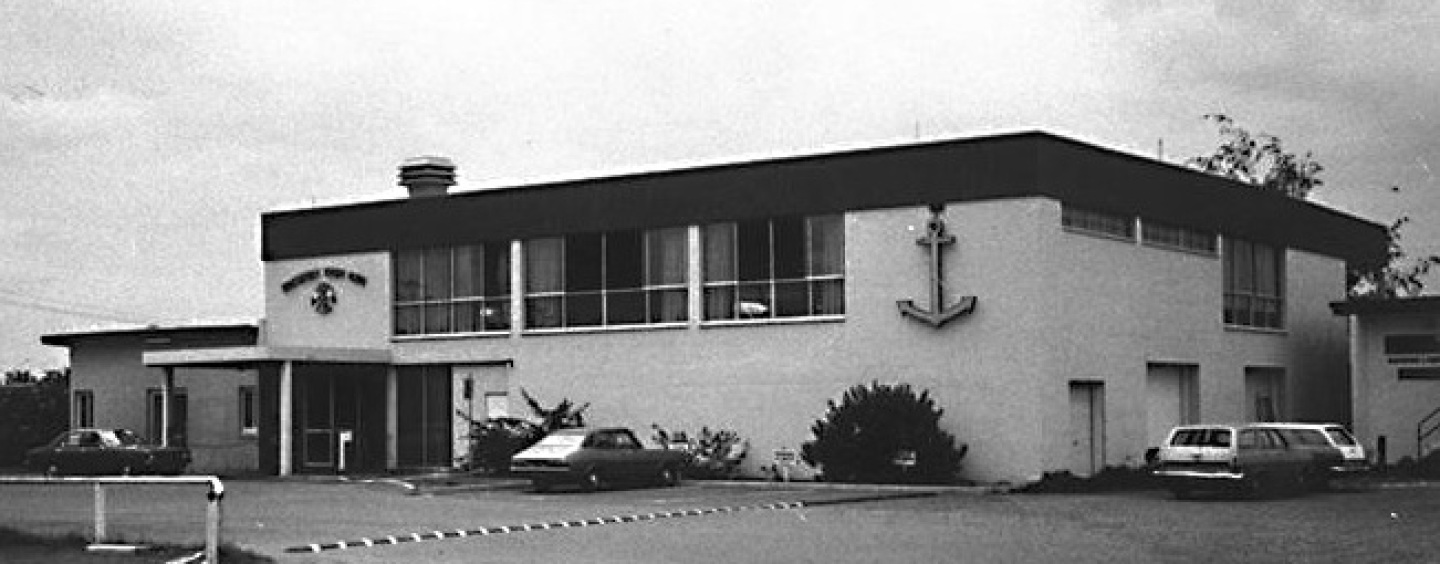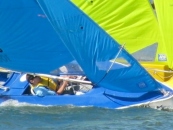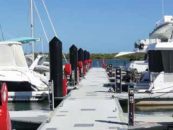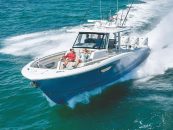“Southport Yacht Club (SYC) membership is the most cosmopolitan in Australia. From every part of the nation people flock to Queensland’s Gold Coast to take up permanent residence. Many of the newcomers are keen boaties or yachties: the Gold Coast marine lifestyle was a major reason they decide to settle here. Before moving to the Gold Coast, most such people belong to a yacht club and often played an active role in its operation. Since its founding, the SYC has received a regular infusion of experienced new members whose input has benefited the Club,” wrote the historian and acclaimed local journalist, Alexander McRobbie, in his book, The History of Southport Yacht Club (1996).
In 2016, the Club celebrates the 70th anniversary, and today, as in McRobbie’s time, the success and driving force of SYC is only possible through the dedication of the members. It is unlikely that any of the early members foresaw their Club and its facilities develop into a multi-million dollar business enterprise and the jewel of Queensland boating.
The Club remains an interesting place to socialise with frequently arriving vessels from around the world. The crew, whether they be race crews or married couples on a journey, have navigated many a treacherous sea, regularly dock at the Club, and spend their nights at the bar sharing stories of sailing adventures across the oceans.
HISTORY:
The Broadwater was first described by a passing 1822 naval ship captain as a “large lagoon”. The first recorded Broadwater sailing club was in 1880, when four prominent Southport residents staged races among themselves and were sometimes joined by visiting yachtsmen. These organised events and other spontaneous regattas brought great intrigue to the locals, giving birth to the idea of a local yacht club. However, a tragedy during one of these races that claimed the lives of three crew, set back any successful plans for a club for many years.
In 1897, a Southport Easter Regatta was held. From then on, regattas became a feature of the Southport social life with spectacular sail pasts. In the early 20th century, The Southport School (TSS) regatta was also a popular annual sailing event. And by the 1940’s, the Broadwater had become busy with both recreational and commercial vessels. The Brisbane yachting fraternity would cruise the passages south to discover the beauty of the Broadwater areas. The voyage was best described as “a one bottle of rum trip” by the skipper of Maid of Sker to explain how long it would take to travel from Brisbane to Southport.
During World War II, a group of local boat owners offered sailing trips, with a picnic at Jumpinpin, to injured returned serviceman as part of their rehabilitation. These boat owners would eventually become the foundation members of the newly formed Southport Yacht Club.
On April 5, 1946, the mayor of Southport, John Proud proudly chaired a meeting of approximately 70 people at the Southport Council Chambers in Nerang Street. After a considerable discussion, it was agreed that further meetings would take place to organise the details for the formation of the yacht club. Eventually, the Southport Yacht Club was formed with Lindsay Firth as the very first Commodore.
The Club’s early objectives were to acquire land for a club house, define and beacon all channels, improve picnic spots in the bay and rivers, and lobby to have the main channel deepened.
Almost weekly, there was a new boating disaster at the Southport bar possibly claiming more wrecked vessels than any other bar in the world. The members of the yacht club were often asked to assist visiting vessels wanting to cross the treacherous bar.
Many of the early members would go on to feature prominently in the management and urban development of the city of Gold Coast. Fortunately, around this time, expert town planner, Dr Karl Langer, a well-known Brisbane architect, during the planning the Main Beach precinct, included a site for the Club with ample surround car parking space on arguably the best site along the whole Broadwater.
After the Club’s second year, the members approached the Southport Trainee Squadron, which had been formed way back in 1926, to join Club at their Hollywell base. Technically then, the SYC junior club is in fact older than the senior club.
It would be nearly 10 years before the first club house would be built. As Main Beach was zoned as an upmarket “Brick Area”, the construction would need to be permanent and the ground level raised before building. By 1952, the Club had 70 members. After much lobbying for financial backing and fundraising by the ladies’ committee, construction of the club house began in 1953.
The modest club house was officially opened in 1956. There was no fancy bar servicing alcohol, nor was there a restaurant serving food. However, the members were thrilled that basics such as bread, milk, butter, ice and the newspaper were available. In 1959, with a membership of 203, the Club successfully acquired a liquor license, and also installed a telephone.
The early members were community-minded and helped shape the development of the Broadwater. Their pioneering dedication to marine conservation in the area remains until this day.
By the late 1950’s, boating on the Broadwater was booming. All this, well before the advent of riverfront homes and canal estates, many boat owners simply moored their boats close to their homes, causing what was coined as “nautical congestion”. By 1966, members were informed by the then Commodore Lee Kilner, that impressive numbers of overseas and interstate guests were visitors to the Club which made the Club unique, and that these guests were helping to keep the Club up-to-date in its thinking.
By 1967, Queensland was heading towards becoming one of the largest recreational boating destinations in the country. The state government began implementing a mooring fee of $5 per feet per year, even if the boat owners were up in arms.
In 1969, the first lady skippers race was held. The Club has always been a sign of the times, so up until that year, the Club insisted that boating was predominantly for men. It was in 1974 that the Club’s constitution was amended to permit the formation of what was initially called a “Ladies Auxiliary”, formally titled the Associates Committee, where ladies were granted an associates membership. However, it was not until the half year meeting on April 1986, when the club finally decided to admit women as full members, should they so desire.
In 1972, due to demand in the area, the Club opened a slipway that had a waiting list for those wanting to slip their boats. A few years later, approval was granted by the Department of Harbours and Marine to build a floating marina. However, it would take several years and a unique financing arrangement by some members to have the first stages of the marina ready for occupancy. Between 1977 and 1981 the marina was continually expanded due to growing demand. The floating marina and hard stand were officially opened in 1986.
In 1982, another major Club facility was built on South Stradbroke Island, on a sandy beach front block, suitable for offshore anchorage that was offered to the club by the council. Many committed members organized themselves in working bees and set sail with members’ boats carrying building equipment and supplies. After a few years of hard work, the area came to be known as the DUX and was equipped with amenities and a caretaker’s residence. At the 1985 peak of the season, there were 85 boats anchored for the weekend at the Dux Basin. Finally in 1991, after an expansion of the area and various improvements on facilities, a crowd of 400 people gathered on the picturesque island location to see what had been achieved by volunteers after 10 years of dedicated service.
In 1992, through a generous sporting grant from Jupiters Casino, an amount of $500,000 was received by the Club, which was used to build new facilities and amenities at Hollywell. The development of the junior facilities established the Club and the Gold Coast as a yacht racing force on both national and international levels.
After several years of resistance from members, the Club finally installed poker machines in 1993 to generate much needed operating funds. The introduction of the poker machines led to the creation of a social member status at the Club. The social members had no voting rights and most had no interest in boating.
That same year, the Club began its involvement in the most ambitious project in its history. The SYC was successful in its $2.6 million dollar bid to make the Gold Coast as the Australian training base from March to September in 1994 for the oneAustralia and Sydney 95 America’s Cup teams. The wind and wave patterns of the shores of the Gold Coast were similar to those expected in the San Diego-held competition in 1995. To prepare for the training, the Queensland Department of Transport very quickly dredged a channel to the Seaway. The Club grounds were transformed into a high-tech training facility complete with a huge work shed and a massive crane used to lift the yachts in and out of the water. Even though the oneAustralia yacht was defeated by the Kiwis, this initiative delivered between $300,000 and $400,000 to the Club including a large L-shaped floating marina and a significant increase in membership.
Continuing the excitement at the Club, in May 1995 a $17 million full-scale jarrah replica of Captain James Cook’s Endeavour berthed at the Club, with a total of 18,000 visitors coming to see the vessel over nine days, 7,000 of which actually visited the Club. By this time, the Club had over 800 social members.
Millennium Milestones
Today’s Club is as much a remarkable story of the survival of a community initiative, as it is about the Club’s teams surviving out at sea. Having overcome many hurdles in their formative years, such as financial constraints with long periods of waiting and hoping, and extended periods of fund raising. The members have always held on with a passion. This persistence has seen the Club eventually prosper to become financially sustainable.
After 70 years of continuous investment, SYC facilities have expanded to become a multi-purpose boating mecca that caters to the service requirements of boat owners and social life of Club members and casual visitors. The floating marina has been expanded to 300 berths with 10 super yacht berths. Every year, they receive between 500 and 800 visiting vessels. The most significant investments in facilities and amenities include the renovations to the marina in 2007 (which was awarded the as Best Marina in Australia in the same year) and the major renovations to the Main Beach Clubhouse in 2008. In 2011, a major renovation was undertaken at the Hollywell Clubhouse. In 2015, an arrival/departure pontoon was installed at the Dux. These vast investments did not go unnoticed, having been given a Gold Anchor accreditation of 4-1/2 Anchors by the Marina Industries Association in 2014 and awarded the Rowland Best Innovation Award to the Club in 2016 for the Waterscape pontoon bar by the Keno and Clubs Queensland.
Gone also are the days of an exclusive male membership. The Club is very up to date with signs of the times, and advocates for equal opportunities and progressive thinking. In 2013, a long-time member, Kerry Noyes, was appointed Vice Commodore for Sail. And recently, at the 70th Annual General Meeting of Southport Yacht Club held on 25 July 2016, Kerry was appointed Commodore. She is the first female Commodore of the Club. This is a very significant achievement for Queensland sailing and the SYC community.
The very strict dress code has also relaxed to keep up with the times. Back in the 1960’s, the Executive Board preferred white open-necked shirt with short sleeves, white shorts, and long white golf socks and preferably white shoes. These days, the Club requires you to “dress respectfully in your own style”.
The most challenging aspect of managing the Club is overcoming the perception of exclusivity. The waterfront restaurant and bar is open to the public and the membership packages are very affordable. Although some members are “mega rich”, most members are regular people with a love of boating. The Club is definitely “not exclusive nor snobby”.
In 2013, SYC was awarded Best Casual Dining by Clubs Queensland and the prestigious Marina Restaurant of the Year by the Marina Industries Association.
This year, the Club reports over 3,000 members and more than 100,000 annual visitors to the venue. There are over 80 staff employed by the Club. Add to that the many thousands of hours of labour voluntarily contributed by members. This large team of people, working for a common cause, are able to stage over 500 boat races each year, as well as many of the Club’s traditional occasions and a myriad of social functions. All these interactive opportunities provide the community with a hub to meet and partake in on-water activities with likeminded sporting enthusiasts.
Other aspects of the Club that help keep the quality of service to the members and the community involve the Club’s marketing strategies and its sailing programs that encourage young people to participate. The Club’s free learn-to-sail programs are a significant contribution to the local community. In addition, the Club’s marketing manager, Bronwen Hemmings, was awarded Club Super Young Manager Encouragement of the Year 2016 by the Keno and Clubs Queensland.
What is a Club without competition?
The Club has always strived for boating excellence. As far back as 1946, when just a handful of boats jostled for a win, the Club aspired to be the best—to win, no matter the effort required. This belief and the Club’s relentless investment in the future have paid off. The Club’s go-get-it attitude on the water is optimised in one of its homegrown heroes, Mathew Belcher OAM, knighted for his sailing excellence. Mathew, who learned to sail at Hollywell and went on to win a staggering seven world sailing championships that included a Gold Medal at the 2012 London Olympics in Sailing 470 class.
The Club’s recent sailing participation includes wins in the following races: Clipper Round the World Yacht Race (2010), Sabot National Titles (2011), First Sail Paradise Regatta (2012), Nacra Infusion World Championships (2013) and Etchells National Titles (2014)
Today, the Main Beach Clubhouse stands against a dramatic backdrop of international hotels and world-renowned beaches. The boating lifestyle has remained a major draw card to new families looking to reside in the city. Boating has become a significant contributor to the city’s economic success. While the environment, and the accessibility to beautiful sheltered waters and easy access to the ocean are the reasons why boating has become so popular, the founding members of the Southport Yacht Club and all the members throughout its rich seventy year history, who have donated their time and energy over the years, must be acknowledged for their vision and foresight to believe in a way of life closely connected to the waterways. Boating on the Gold Coast is what captures the attention of many of us. The city and the Club will continue to prosper as the rest of the world discover our boating life and the historic and cosmopolitan Southport Yacht Club.
—–
This year’s 70th anniversary celebrations at SYC officially began on April 19 with the Birthday Bash. Festivities included past and present members of the navigation division joining the 2016 SYC Open Power Boat Navigation Event. On July 9, the SYC 70th Anniversary Gala Ball was held with live entertainment and dinner dance.
The 70th Anniversary Sail Past and Blessing of the Fleet will be staged at the Main Beach Clubhouse on September 3. It will be a fun family day with vessels being dressed and decorated. An SYC Members-only anniversary celebratory event on October 1 will feature a performances from legendary Australian musician Daryl Braithwaite.
—–
Written by Andy Kancachian. This information was made possible by the extensive documentation by historian and award winning journalist Alexander McRobbie, and contributions by SYC General Manager Brett James, Waterfront Manager Mark Riddell, Marketing Manager Bronwen Hemmings and Membership Coordinator Rosemary Austin.



























